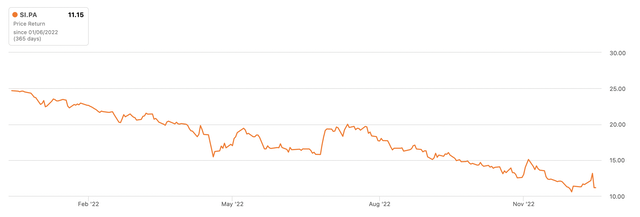[ad_1]
Chinnapong
Bulls and bears alike knew it was coming, but Silvergate’s (NYSE:SI) market update last Thursday that deposits had fallen by $8.1 billion, around 70% of its total deposits, still came as a shock. This was a withdrawal rate more severe than some banks during the Great Depression and came on the back of a crisis of confidence. Following the implosion of a number of crypto outfits last year, managing counterparty risks has come to be one of the most dominant themes for crypto companies. 2023 was kickstarted with Gemini, a large cryptocurrency exchange and customer of Silvergate Exchange Network, publishing an open letter to the provider of its Earn product after withdrawals had been suspended for over a month with no updates.
Silvergate is cutting 200 employees, around 40% of its total, recording a $198 million impairment charge related to assets purchased from Diem, the former stablecoin project of Meta’s Facebook, and moved to realize a loss of $718 million through the forced sale of $5.2 billion of debt. The company still maintained total debt securities at a fair value of $5.6 billion. These are safer U.S. government and agency-backed debt.
Silvergate’s 5.375% Non-Cumulative Series A Preferreds are now trading at a 55% discount to their redemption value. I think these are the best way for those still bullish on the company to play any potential recovery. Why? They currently yield 12% with the preferreds trading at $11.15 against their $1.344 coupon paid quarterly. The bearish case for these would have seen an announcement that all payouts were entirely being suspended included in the Thursday update.
Preferreds Are Trading At 45 Cents On The Dollar
That the coupon was maintained against what would arguably have been the best time to announce a cut has helped Silvergate to stabilize broader confidence from depositors, shareholders, and regulators. Further, the preferreds cost Silvergate just $2.7 million per quarter, a relatively minuscule amount for a business that did $100 million in cash flows from operations in the third quarter of its fiscal 2022. The company also had $4.6 million in cash and equivalents as per the Thursday update. This was in excess of deposits, which had declined from $11.9 billion to $3.8 billion. Hence, preferreds owners might be forever safe from a dividend suspension.
Bears would be right to flag Moody’s downgrade of the long-term deposit rating on Silvergate Bank, the main operating unit, from Baa2 to Ba1. This is essentially a fall from the lower end of investment grade to junk status. The most near-term impact of this downgrade on the preferreds would likely be the prevention of a level of institutional participation, but it does not change the overall long-term value potential of the preferreds.
The play for alpha here is the Series A return back to their $25 redemption value within the next three years on the back of sentiment improving and the current crisis mode of the industry easing. This would imply a more than 100% upside on capital with an additional 12% a year from coupon payments. Just to be clear, I think the core business is set for a marked decline, but I’m leaning towards starting a position in the preferreds. The core risk of the preferreds remains their non-cumulative clause, although this still did not nudge Silvergate towards a suspension.
Revenue And Earnings Set For A Marked Decline
The Gemini spat with Digital Currency Group-backed Genesis is a bad omen for the industry. DCG has often been described as one of the most storied crypto institutions. Whilst there are some rumours of a Genesis bankruptcy filing, the current freeze alludes to a continuation of a crisis set to affect sentiment and the broader momentum of Silvergate’s operations.
The situation is not catastrophic. The Silvergate Exchange Network had an average daily volume of $1.3 billion in the fourth quarter, up from $1.2 billion in the third quarter. Leverage commitments for the network did drop to $1.1 billion from $1.5 billion in the third quarter. Expectations are now for deposits to keep on falling as the broader industry continues to reel from the fourth quarter disruption. Bank of America is penciling an earnings per share of $0.67 for the full fiscal year 2023, a roughly 90% decline from its 2022 comp. This is in comparison to the consensus for EPS to come in at $2.46 prior to the fourth quarter disruption.
Overall, revenue and EPS are set for a decline, but the company is still expected to churn out a profit. This bodes well for the owners of the preferreds. The commons could very well rally when volatility calms and on broader positive stock market sentiment, but for now, it looks as though things could get worse in the interim. The preferreds make a good play here and I’ll likely start a position towards the end of January.
[ad_2]
Image and article originally from seekingalpha.com. Read the original article here.


